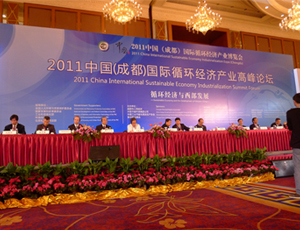
During the China International Sustainable Economy Industrialization Expo, held on Nov. 19-20 in Chengdu, government officials adhered to the party line. By focusing squarely on enhancing the country’s so-called circular economy (CE), the message to conference attendees, whether vendors, analysts, lawyers or academics, was clear: sustainable technology is key to the future of the Chinese economy.
But firms working in China said that, despite the opportunities, there are challenges as well.
Officials said they are striving for an economic system that minimizes environmental impact. Chengdu, the capital of Sichuan, is one of the Chinese cities most actively pursuing a development path departing from the West’s industrial model. By seeking high-resource efficiency and low pollution, it adheres to the Communist Party’s 12th Five-Year Plan, which is focused on implementing CE as part of its "Go West" initiative, officials said.
During his keynote address, Zhao Gang, deputy director of the Ministry of Science & Technology as well as the National Development & Reform Commission’s Renewable Energy and New Energy International Technology Collaboration Planning Office, said, “China is not only in the technology innovation and investment industry, but it is emphasizing the circular economy … to attract a lot of talent and entrepreneurship.”
More specifically, the Chinese government is focusing on technology as a way to enable environmental protection, explained Wang Qingxi, deputy chairman of the Environment and Resources Protection Committee of the National People’s Congress.
The Chinese government is interested in developing as many streams of energy as possible, especially conversion to power efficiency. According to Dr. Richard Hardiman of Israel’s Weizmann Institute of Science, power efficiency would be “very useful for China’s needs.”
Wang Bao Hua, director of the Chengdu Economic and IT Commission, pointed to renewables, such as wind, “which is very developed in China,” and nuclear, which is not. LED technologies are being quickly developed thanks to a recent injection of funds. Similarly, clean-vehicle projects have received investment injections, which is crucial given that “the pollution mix is shifting from industry to transport in the two great vehicle nations”—the U.S. and China—said Wang.
Others pointed to a need for developing energy efficiency in buildings. "Because of the long life of a building, it’s important to start sooner rather than later,” said Jonathon Woetzel, director in New York City-based McKinsey’s Shanghai office.
But some firms pointed to challenges to working in China.
For some companies, the challenge is not a lack of available funds, but rather “the inability to access different forms of funds on a commercial level,” such as funding from private equity or investment banks, said Thomas Dreesen, president and CEO of Philadelphia-based EPS Capital Corp. Most of the funding for technology projects comes from the government, he said. This poses a challenge for foreign companies seeking to enter China, as it’s “not a level playing field, given the significant government influence,” said Manau Keegan, senior vice president and senior relationship manager for National CleanTech and Emerging Tech Markets at San Fracisco-based Wells Fargo.
One of the biggest concerns for foreign companies in China is intellectual property rights, said Gerald Page, managing director at Bejing-based Equinox Energy Partners Corp. He explained, “On the China side, companies are provided incentives, but they ultimately will want tech transfer.”



Post a comment to this article
Report Abusive Comment